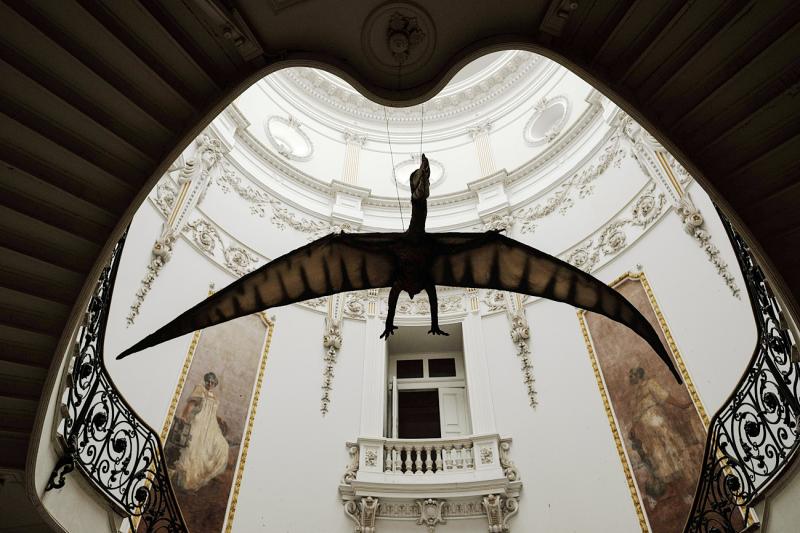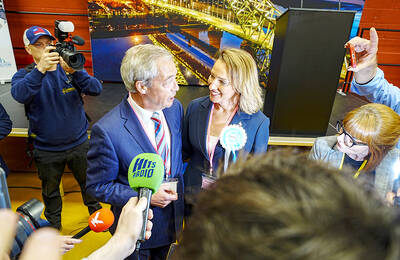With an estimated 7m wingspan, 40 razor-sharp teeth, a circular crest below its jaw and no living relatives, a new species of pterosaur discovered in outback Queensland is being touted as the closest thing Australia ever had to a mythical dragon.
The creature, thought to have lived 105 million years ago, is the largest known flying reptile on the Australian continent and has been described for the first time in an article published yesterday in the Journal of Vertebrate Paleontology.
Tim Richards, a University of Queensland doctoral candidate, led a research team from the Dinosaur Lab in the university’s School of Biological Sciences to describe the specimen.

Photo: AFP
Richards said that by comparing a partial jawbone with other pterosaur fossils, researchers were able to estimate the specimen’s proportions and establish that it was an entirely new species.
They found it would have likely had a 1m-long skull, with a pointed snout, proportionately long wings, short hind legs and no tail, and was covered in a light fuzz.
“It wasn’t built to eat broccoli,” Richards said. “It would make magpie swooping look very trivial. It would have been a fearsome sight. It’s only a few meters in wingspan shorter than a hang glider.”
“From its morphology, it’s mostly likely adapted for a carnivorous lifestyle. Its teeth were probably designed more for holding on to slippery fish,” he said.
The animal belonged to a group of pterosaurs known as anhanguerians, which thrived for 200 million years, lived on every continent and became highly specialized to their environment.
It has been given the scientific name Thapunngaka shawi — a combination of the Wanamara nation words for “spear” and “mouth,” and the surname of the person who discovered the fossil.
The remains were found in June 2011 on Wanamara country, near Richmond in northwest Queensland, by Len Shaw, a council worker who would search for fossils during his lunch break by using his front loader to gently pour water on the rock face to identify bone from rock.
When Shaw noticed the sockets of the jaw, he immediately contacted a local museum, Kronosaurus Korner.
Richards said pterosaur fossils were extremely rare worldwide, as they were so highly adapted to a life in flight that their bones were just millimeters thick, hollow and extremely fragile.
“Pterosaurs don’t preserve well,” Richards said. “Most of these things likely fell into the sea on death and were gobbled up by predatory beasts in the sea. A lot of them would never have made it to the sea floor to start that fossilization process.”
About 100 million years ago, two-thirds of the area that is today Queensland was covered by the Eromanga sea, a shallow body of water that stretched past the Northern Territory border and down into New South Wales.
Steve Salisbury, a coauthor of the paper and Richards’s doctorate supervisor, said the find was especially significant since pterosaurs — which were distinct from dinosaurs — became extinct at the end of the Cretaceous Period and have no living relatives.
“There’s been nothing like them ever since they went extinct. It makes it exciting to find new pterosaur fossils, because we only know them from fossils,” Salisbury said.
“They lived alongside dinosaurs and they’re a group of reptiles related to dinosaurs, but they’re not dinosaurs. It flies like a bird or a bat, but it’s not one of them. What can you say it’s like? A dragon. A fuzzy dragon,” he said.
Kailah Thorn, a University of Western Australia paleontologist and curator of the Edward de Courcy Clarke Earth Science Museum who was not involved in the study, said this was the third species of pterosaur named since 2007.
“Finding new pterosaur material in Australia is always exciting,” Thorn said. “Pterosaurs have more fragile, lightweight bones built for flight, that are less likely to preserve than the bones of dinosaurs.”
“Although all the authors had to work with is the deep chin and front portion of the lower jaw belonging to this animal, it’s enough to differentiate it from the other named Australian pterosaurs and estimate the comparative scale of this species,” she said.

Kehinde Sanni spends his days smoothing out dents and repainting scratched bumpers in a modest autobody shop in Lagos. He has never left Nigeria, yet he speaks glowingly of Burkina Faso military leader Ibrahim Traore. “Nigeria needs someone like Ibrahim Traore of Burkina Faso. He is doing well for his country,” Sanni said. His admiration is shaped by a steady stream of viral videos, memes and social media posts — many misleading or outright false — portraying Traore as a fearless reformer who defied Western powers and reclaimed his country’s dignity. The Burkinabe strongman swept into power following a coup in September 2022

TRUMP EFFECT: The win capped one of the most dramatic turnarounds in Canadian political history after the Conservatives had led the Liberals by more than 20 points Canadian Prime Minister Mark Carney yesterday pledged to win US President Donald Trump’s trade war after winning Canada’s election and leading his Liberal Party to another term in power. Following a campaign dominated by Trump’s tariffs and annexation threats, Carney promised to chart “a new path forward” in a world “fundamentally changed” by a US that is newly hostile to free trade. “We are over the shock of the American betrayal, but we should never forget the lessons,” said Carney, who led the central banks of Canada and the UK before entering politics earlier this year. “We will win this trade war and

‘FRAGMENTING’: British politics have for a long time been dominated by the Labor Party and the Tories, but polls suggest that Reform now poses a significant challenge Hard-right upstarts Reform UK snatched a parliamentary seat from British Prime Minister Keir Starmer’s Labor Party yesterday in local elections that dealt a blow to the UK’s two establishment parties. Reform, led by anti-immigrant firebrand Nigel Farage, won the by-election in Runcorn and Helsby in northwest England by just six votes, as it picked up gains in other localities, including one mayoralty. The group’s strong showing continues momentum it built up at last year’s general election and appears to confirm a trend that the UK is entering an era of multi-party politics. “For the movement, for the party it’s a very, very big

SUPPORT: The Australian prime minister promised to back Kyiv against Russia’s invasion, saying: ‘That’s my government’s position. It was yesterday. It still is’ Left-leaning Australian Prime Minister Anthony Albanese yesterday basked in his landslide election win, promising a “disciplined, orderly” government to confront cost-of-living pain and tariff turmoil. People clapped as the 62-year-old and his fiancee, Jodie Haydon, who visited his old inner Sydney haunt, Cafe Italia, surrounded by a crowd of jostling photographers and journalists. Albanese’s Labor Party is on course to win at least 83 seats in the 150-member parliament, partial results showed. Opposition leader Peter Dutton’s conservative Liberal-National coalition had just 38 seats, and other parties 12. Another 17 seats were still in doubt. “We will be a disciplined, orderly